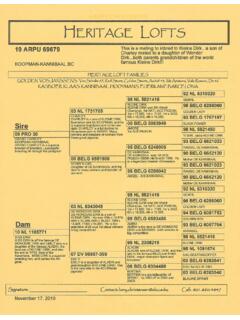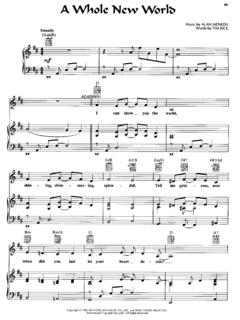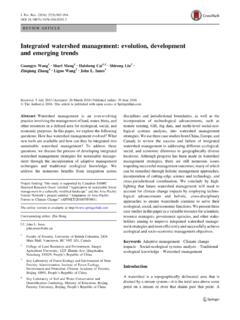Transcription of 6 UNDERSTANDING UNDERSTANDING THE COMMUNITY ... …
1 UNDERSTANDINGTHE COMMUNITY676 PRAMILA AGGARWALUNDERSTANDING THE COMMUNITY What is COMMUNITY ? Types of COMMUNITY Geographic COMMUNITY or a Neighborhood COMMUNITY of Identity COMMUNITY of Interest or Solidarity Intentional How to Work Effectively in the COMMUNITY ? Begin by Posing Questions Ask COMMUNITY Needs Assessment and COMMUNITY Assets Mapping Creating COMMUNITY Space Diversity Power COMMUNITY Apply What You Have Learnt Learning ObjectivesAfter going through Unit 6, it is expected that you would be able to Analyze your COMMUNITY Identify the diversity in COMMUNITY in which you work Apply your UNDERSTANDING and analysis in your practice and become moreeffective in your work as adult educators Recognize your own status/role in the COMMUNITY and its significance toyour work in the IntroductionPurpose of Unit 6 is firstly to engageyou in the notion of COMMUNITY that isdynamic and diverse in every aspect:class, religion, age, gender, language,and caste and secondly to provide sometools and strategies to be more effectivein your role as adult educators.
2 To section cover the firstobjective of the lesson and section Section introduce tools andstrategies to apply the concept of COMMUNITY to your work as an What is COMMUNITY ?Please examine the followingdefinitions/descriptions of communityand see the degree to which they applyto your specific COMMUNITY . You mayfind that they may not apply to yoursituation in their entirety. COMMUNITY is a concept to describea social organization that isconsidered fundamental totraditional to Indian society such asjati, village or religious sect. Suchcommunities are often regarded asnatural grouping based on ties ofshared blood, language, history,territory and above all, culture.
3 (Upadhya, 2006) In their edited book, Lives inContext: the Art of Life HistoryResearch, Coles and Knowles (2001:11) define COMMUNITY as Clustersof individual lives make-upcommunities, societies and understand some of thecomplexities, complications, andconfusions within the life of just onemember of a COMMUNITY is to gaininsights into the collective . Bill Lee (1992) defines COMMUNITY ,simply as a group of people who havesomething in common. In Greek language it means fellowship or a group of peoplewho come together for mutualsupport and to fulfill their basicneeds. For Boothroyd (1990) a communityis A Human system of more thantwo people in which the membersinteract personally over time, inwhich behavior and activity areguided by collectively- evolved normsor collective decisions, and fromwhich members may freely secede.
4 Roberts (1979) sees a COMMUNITY as a collection of people who havebecome aware of some problem orsome broad goal, who have gonethrough a process of learning aboutthemselves and about theirenvironment, and have formulateda group objective .As we can see from a sample above, COMMUNITY as a concept connotes a widerange of meanings. It is popular inseveral academic disciplines as well asin everyday usage. While for some, ittakes a long time for individuals to forma COMMUNITY , for others it is possible tocreate easily and fast: such is the casewhen real state developers use it todescribe new buildings in terms ofcommunity a COMMUNITY coming nearyou.
5 They use COMMUNITY as a productor a commodity to be bought, sold orexchanged in the market. Often it isused to describe an organization orinstitution such a workplace, a schoolor a college or university to imply acommon spatial bond. At other timeswe use it to talk about people who haveshare a common characteristic such asreligion. caste or will also discover that the conceptsof COMMUNITY , identity, and culture areused interchangeably in literature. Theliterature on nature and function ofCommunity can be divided into roughlytwo opposing views. While some believethat it is natural and key to humanwelfare, others argue that communitiesare non-democratic and stifle individualgrowth and freedom.
6 Our objective isto become familiar with these scholars have examined thecomplex and fluid nature of communityas a concept because it and lends itselfto quite varied interpretations. MoreUNDERSTANDINGTHE COMMUNITY69recently it has become prominent in thefield of International Development,reconstruction of war torn countries bythe west, either as a suffix or a prefix,building communities for example. Onething is certain; it stands for somethinggood and desirable. You might havecome across phrases such as: communitydevelopment, COMMUNITY capacitybuilding, COMMUNITY economicdevelopment , we can t assume thatcommunity is always benign andsupportive.
7 Just like many families, itcan be oppressive too. A COMMUNITY mayhold on to value system that ispatriarchal, repressive, exclusive andundemocratic. In short, it may mirrorall the ills in the larger society. Individualshave may have no choice in theiraffiliation to a COMMUNITY / culture orhow they are perceived by the worldoutside. Furthermore, it is assumed thatindividuals have a choice about theirbelonging; that they willingly join acommunity similar to joining anorganization such as a trade union or asocial club. This assumption can be falseas individuals may not be conscious oftheir membership to a particularcommunity with which they areassumed to feel an affinity.
8 In fact, attimes we might be quite upset andhorrified when we get seen as part of acertain COMMUNITY . For example becauseof my Muslim name, I am seen as havingsympathy with terrorist and assumedto be pro Pakistan, resulting in my beingisolated from the larger COMMUNITY . Itis not only those ignorant people outthere who make assumptions aboutpeople they know nothing about, we (educators) too carry stereotypes andprejudices and being aware of and beingconscious of our own baggage is a goodplace to start. Let us now look at thevarious types of Types of CommunityBefore we move on to the types ofcommunities, it is worth mentioningthat all communities are dynamic innature.
9 They act, interact, evolve andchange as a result of larger political andeconomic forces as well as internal andexternal speaking there are three typesof communities. These are not mutuallyexclusive as we all are members of thesetypes concurrently. For example: I aman older woman who likes to walk inthe park in Shahadra. As I live inShahadra, it makes me a member ofthat geographic COMMUNITY . As I meetother older women in the park, it makesme a member of a COMMUNITY ofinterest as well as identify. You will findthat all of us have several interests andidentities and therefore belong to manycommunities simultaneously.
10 At the sametime our interests change and so doidentity. We will develop these ideas insome 3. 1 Geographic COMMUNITY or aNeighborhoodIt is the only type of COMMUNITY aboutwhich there is agreement amongstscholars. It has physical boundaries bywhich make it distinct or separate, suchas a river, a street. In a town theremight be several neighborhoods, eachwith some special attributes: caste,religion, rich and poor. In addition, aneighborhood usually has a diversepopulation with individuals and groupsoccupying different physical space. It is70 PRAMILA AGGARWAL important to observe who in a villageor a section of a city or town, lives in acleaner part, and who lives near an opensewer, or who has more space and whohas less; how far or close they are fromthe centre of the village; how much theyhave to walk to get water etc.






